You are reading the older HTML site
Positive Feedback ISSUE
16
november/december 2004
piega of switzerland
C2 loudspeakers
as reviewed by Brad Morrical
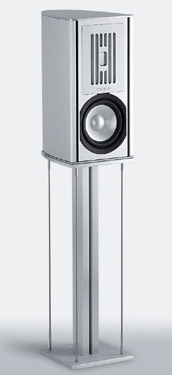
|
BRAD MORRICAL'S SYSTEM
LOUDSPEAKERS
ELECTRONICS
SOURCES
CABLES
ACCESSORIES
|
Like many people, I started out in hi-fi with bookshelf speakers when I was in college and had little space for large loudspeakers. My first taste of high-end audio came when I bought a pair of Paradigm 5se mkIIs. From there, an Infinity Modulus Satellite/subwoofer system gave me true high-end resolution and introduced me to planar magnetic drivers. The wonderful little Modulus satellites (still on the cutting edge of aesthetic design, in my opinion) possessed EMIT K tweeters, the same tweeters Infinity used in cost-no-object speakers like the IRS Vs and Betas. The Modulus speakers demonstrated to me what delicate and fast tweeters can add to musical pleasure.
Wanting to stretch my hi-fi legs, I sold the Modulus system in favor of Dynaudio kit speakers, which led to Dynaudio commercial speakers, then DIY speakers using conventional cones and domes. However, I never forgot about the aliveness and openness of planar magnetic drivers, which seemed to be missing from more conventional speakers. A few years later, I became the owner of fully planar dipole ribbon loudspeakers, the Apogee Caliper Signatures. I find ribbon and electrostatic speakers to be the most appealing loudspeaker technologies. Although planar magnetic and true ribbon drivers have gone from being curiosities to being the de facto standard for high frequency reproduction, the use of planar magnetic midrange drivers remains rare. Aside from a few early- to late-90s Infinity models (the IRS series ending with the Epsilon and Omega), and some exotic designs from Genesis, Carver, and more recently, VMPS, very few have done this.
Only the likes of Apogee, Magnepan, and Eminent Technology have attempted full-range planar magnetic designs. Most companies have tried to balance the desire for bass and smaller size by trying to marry ribbon or planar drivers to conventional cone woofers. Cone speakers, typically used in a ported box, tend to show the phase lag and lazy behavior of their high-Q nature. Sealed boxes or dipole woofers fair better from a transient point of view, but deep bass extension usually suffers unless equalization is applied. However, the transition is often audible due to cone and cabinet colorations, as well as the transient speed of the planars. Only a few extreme attempts (Infinity and Genesis with their sealed and servo-controlled woofers, or the Gradient dipole woofers for the Quads) have been successful in blending the two technologies.
What does this have to do with Piega? From the beginning, Piega's top models have incorporated planar magnetic tweeters, and unlike many manufacturers, they designed and built their tweeters in-house. Later, also in their top models, Piega began to use in-house-designed planar magnetic midrange drivers. None of this was new, since both Infinity and Magnepan had been building these kinds of speakers since the 1970s, but Piega was one of very few companies attempting this kind of innovation. While a small company (see my factory tour in PFO Issue 13), Piega has gained a big reputation in Europe and is becoming more and more known globally. Earlier Piega models sounded good, but the tweeters and midrange drivers stood out from the rest of the design. They were also expensive, and more likely to fit a customer's aesthetic need than the desire to reach for the brass ring of high-end music reproduction. This changed with the introduction of their latest flagship, the C40, which introduced the world's first coaxial planar magnetic midrange/tweeter. It is clear that this driver forced Piega to rethink their design philosophy. They have essentially designed a whole system around this driver, in order to match its speed and precision. The result is a speaker that far surpasses their previous efforts. The new design includes changes like a new C-shaped cabinet (thus the speaker's name), made from a solid piece of cast aluminum, and ultra-fast, small, and lightweight aluminum cones to match the speed of the midrange/tweeter.
The compact C2 LTD follows in its father's footsteps by being the smallest speaker of Piega's C line to use the coaxial driver. A new, smaller, midrange/tweeter was developed for every model in the C LTD line below the flagship, so while the C2 LTD is no bigger than most two-way loudspeakers, it is in fact a three-way design. The system consists of one 6.5-inch aluminum skin/paper cone and the coaxial driver. The cabinet, although similar in appearance to the all-aluminum C40, consists of layers of MDF and damping material covered in an aluminum veneer. Interior bracing is extensive, and bitumen damping sheets are applied inside the cabinet to further reduce cabinet resonances. The woofer is loaded with a small tuned port that opens to the rear. The speaker binding posts are high quality WBTs, thankfully not the ones with the plastic shrouds around them, which make spade connection a real pain. Interestingly, the speaker is bi-wirable but not tri-wirable, meaning that the midrange/tweeter is treated as a single entity.
I did not think that the fit and finish of the binding post plate was as good as that of the rest of the speaker. The plate was not flush with the body of the cabinet, but it was uneven, suggesting that it was meant to be flush. I also did not think much of the method used to hide the mounting bolts on the woofer. The gray rubber boot that surrounds the metallic silver woofer somehow cheapens the speaker's otherwise exquisite appearance. I know this is a bit nitpicky, but a customer spending this much money deserves a perfect appearance, and the C2 LTDs fell slightly short in this regard. That said, I must admit that the speakers look elegant in my room, and that their high-tech appearance also had my girlfriend's approval. WAF will be very high with these speakers.
I was provided with a set of the Piega stands. The center posts of these elegant stands are filled with sand. Metal "strings" run from the top to the bottom plates. Although the stands are an expensive option, I assume that most C2 buyers will spring for them, as the speaker can be bolted directly to the stand, making them essentially one unit. They are not the most stable stands I have encountered, because they have exactly the same dimensions as the C2. This no doubt enhances their aesthetic appeal, but it results in a top-heavy speaker that a child might be able to knock over. Though I did not have a child around to conduct such a test (controlled, of course), no accidents occurred in my listening room.
The coaxial driver is the heart of this speaker, and determines its character. The driver is made from extremely thin Kapton film with chemically etched aluminum traces for conducting the audio signal. The midrange and tweeter are on the same piece of film, and are decoupled from each other by vertical cuts along the sides of the tweeter and by the placement of damping material around its periphery. The midrange part of the driver is push-pull in design, meaning it has magnets on both the front and rear. This allows it to see the same magnetic field regardless of excursion, and allows it, at least in theory, to be more linear than it would be if there were magnets only on one side. The tweeter section is single-ended, with magnets on the rear only. This was done to prevent diffraction problems that would occur if rows of magnets were in front of the membrane.
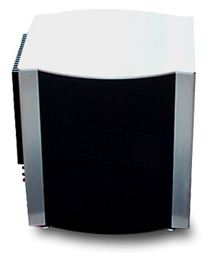 The P1 MkII subwoofer is compact but very
heavy. It shares the same aluminum-wrapped aesthetic as the C2. I didn't receive
many details about this sub, but was able to ascertain that it uses a Peerless
woofer, one of their new extra-long-stroke models, along with a passive
radiator. DIYers will know that this is one very capable woofer, with a large
excursion—something like one inch peak to peak—and 20Hz performance when used
with a passive radiator, as it was done here. The amplifier is very
full-featured, even including a Q control so the user can tighten up the bass or
make it extremely full, but the control appears to be an off-the-shelf
component. I was disappointed to see cheap speaker connectors on the back,
especially for a VERY expensive subwoofer. I used the sub mainly with movies,
but fiddled around with it enough to get a good blend with the C2, and the Q
control was nearly indispensable.
The P1 MkII subwoofer is compact but very
heavy. It shares the same aluminum-wrapped aesthetic as the C2. I didn't receive
many details about this sub, but was able to ascertain that it uses a Peerless
woofer, one of their new extra-long-stroke models, along with a passive
radiator. DIYers will know that this is one very capable woofer, with a large
excursion—something like one inch peak to peak—and 20Hz performance when used
with a passive radiator, as it was done here. The amplifier is very
full-featured, even including a Q control so the user can tighten up the bass or
make it extremely full, but the control appears to be an off-the-shelf
component. I was disappointed to see cheap speaker connectors on the back,
especially for a VERY expensive subwoofer. I used the sub mainly with movies,
but fiddled around with it enough to get a good blend with the C2, and the Q
control was nearly indispensable.
I did not do any serious listening to the C2s for about the first two weeks. I was warned by Piega's export director, Carlo Struchtrup, that they would need extensive break-in, but I had to listen right away. I found that the sound wasn't too bad, but I wanted to give the speakers their full measure, so every night I set them up facing each other, wired out of phase, and burned them in with pink noise. This can tell you a lot about how well matched the speakers are. If they are poorly matched, you will still hear quite a lot of sound, but if they are well matched you will hear very little, as the out-of-phase pink noise will cancel itself out. The Piegas passed this test well, even at quite high levels (nearly 90 dB). Only a faint hiss could be heard.
I did not need to do too much positioning to get the optimum sound I could achieve in my room. I initially positioned the C2s a little over three feet from the rear wall, and started with them pointing straight ahead. I plunked the subwoofer between the two speakers, as I lacked the ability to place it in a corner. Later, after some experimentation, I ended up with the speakers slightly wider apart and with a moderate amount of toe-in. Unfortunately, due to the configuration of my room and my gear, I was not able to put them closer to the rear wall to determine the effect on imaging and bass response.
I generally do not like stand-mounted speakers. Why? They tend to sound small, yet if you position them for the best sound, they occupy nearly the same floor space as moderately sized floor-standers. I know the arguments posed by proponents of such loudspeakers—they image better, have fewer cabinet-related problems, and the drivers can be more tightly integrated because a simpler crossover can be used. Still, I like my sound to have realistic scope and dynamic range, which is generally not the strong suit of small speakers. I have heard many floor-standing speakers, especially ones of the planar variety, that do just fine with regard to cabinet noise and driver integration, so I am not convinced of the need for small speakers, except in very small rooms. I have heard many SOTA stand-mounts, such as the JMlab Micro Utopia Be, the Guarneri Homage, and the Dynaudio Confidence 3 (no longer available), but have never had the feeling that I was listening to anything other than small speakers.
Upon firing up the C2s for my first serious listen, I was struck by how large a sound they produced. I could tell at once that these were not going to be struggling little boxes creating a sad musical caricature. The three-way design was surely helping to take some of the strain away from each driver. The soundstage spread beyond the width of the speakers, and the sound was powerful. Bass was decent for speakers with such small bass drivers. The dynamics were superb, capable of rendering real instruments with lifelike presence (from the upper bass on up), though on a small scale, of course. Sometimes there was too much presence. I had the impression that the dynamic capabilities of not only the mid/tweeter, but also the woofer, were extremely high. At no point in my listening did I hear the slightest hint of strain at normal levels. I also had the feeling that the C2s did not suffer significantly from compression effects. Dynamic bursts from relatively uncompressed sources felt very alive. This could have much to do with the fact that the speaker has an above average sensitivity (around 91dB), and that the mid/tweeter has a large surface area for heat dissipation.
The imaging was not as good as I had expected, and there was some phasiness in the high frequencies, similar to what I have experienced with electrostatic speakers, though much less severe. Perhaps I am particularly sensitive to this effect. No one else who heard the C2s commented on it, but I noticed it to the point that I became somewhat annoyed. As a result, I began to experiment with toe-in, since until then I had the speakers pointing straight ahead. With the centers of the tweeters crossed somewhat behind me, I found that the image was much more focused. This was especially obvious with movies. Dialogue was now tightly focused and tied to the screen, as well as being highly articulate. The phasiness was also greatly attenuated. More toe-in put a little too much treble directly in my face. (As you will see in the measurements, the on-axis treble is quite extended, but flat.) I reached the conclusion that the tweeters were quite directional and had a rather steep off-axis rolloff. I left the speakers in this position for the remainder of the review, as it gave good focus without the treble becoming too insistent.
Another thing that immediately struck me about these speakers was the sheer amount of detail they generated. There was so much information, but it was not overwhelming, and it added to the realism of the experience. At first, I thought that the speakers were a little too bright, and I thought that they might become fatiguing. A couple of friends—one of whom owns Stax ESL F81 electrostats, which are among the most revealing speakers I've heard—thought that the C2s' balance was a bit bright. I am happy to report that after living with the speakers for two months, fatigue was not an issue. My listening sessions were usually on the order of three or more hours. The C2s' detail retrieval is positively microscopic, and while I did not hear anything new in my recordings (remember that I have Apogees, and have owned Infinity IRS Betas and Audiostatic ES 100s), I found that the clarity of subtle musical cues was among the speakers' strongest attributes. I found these details relevant, and they helped me get into the music.
One striking difference between the Apogee Caliper Signatures and the Piega C2 LTDs is the way they retrieve ambient information. The C2s are every bit the equal of the Calipers with regard to information retrieval, but ambient cues seem to decay too rapidly, giving a sense that the musicians are in their own little silent spaces. I also feel that there is a slight loss of soundstage depth on most recordings, though the breadth of the stage is very good. At first I thought that the speakers lacked low-level ambient information retrieval, perhaps because of cabinet resonance or driver noise, but I realized upon further listening that they easily resolved even the most subtle instrumental cues. It didn't make sense that low-level ambient information was reduced when low-level instrumental detail was correct. On recordings taking place within a large space, there was enough ambient information to give a sense of that space, so it seemed possible that the C2s were accurately reporting what was on the recording, while the Caliper Sigs, due to their dipole nature, were creating a certain amount of false ambience. While this is almost certainly the case, I have heard monopole-type planar magnetics from VMPS (Ribbon Monitor2s) and Infinity (Renaissance 80s and 90s) that have pretty good ambient retrieval, as did the Infinity Modulus satellites I once owned.
I cannot come to a conclusion on this matter. On dry studio recordings, the Apogees don't sound particularly spacious, and don't appear to be adding false ambience, but with the C2s, decay of room sound (NOT instrumental decay) is even faster. For bigger works, in bigger spaces, the Apogees (like other dipole speakers) give more of a sensation of being in a concert hall. The C2s have a somewhat drier ambience, with more focus on the sound of the instruments being played. This is perplexing. The C2s' reproduction of instruments is about as good as it can get—easily on par with other planar technologies and horns—but ambience seems to decay a bit too quickly. I want to stress again that the C2s could be accurately reporting what is on the recordings, while the Apogee enhance things a bit. A final possibility occurred to me. According to Canadian NRC studies, the way in which a speaker disperses sound affects its soundstage and imaging capabilities. Wide, even dispersion leads to stable imaging and proper soundstage capabilities. Is it possible that the C2s' somewhat limited off-axis dispersion is reducing ambient information? I am not sure, so the jury is still out on this.
Despite this, the C2s resolve low-level
information superbly. One instance was the Teldec recording of Schubert's
Symphony No. 8 ("The Great"). This musical masterpiece features the
interplay between individual wind instruments and the
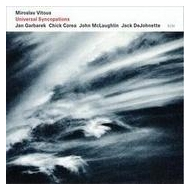 orchestra throughout. Many
speakers do not have sufficient resolution for the listener to determine which
of these instruments (oboe, clarinet, flute, and bassoon) are playing. This is
especially true if two or more of them are playing together. With the C2s, each
instrument is very clearly heard, yet all hang together, and the whole makes
musical sense. The C2s don't forsake the forest for the trees! Complicated jazz,
such as Miroslav Vitous's Universal Syncopations, is startling in its
clarity, equaling both my Apogees and my friend's Staxes in their ability to
float Jan Garbarek's haunting solos above (yes, above) the speakers while
keeping Vitous's bass lines, Chick Corea's piano, and John McLaughlin's guitar
in their own spaces, yet distinct from each other.
orchestra throughout. Many
speakers do not have sufficient resolution for the listener to determine which
of these instruments (oboe, clarinet, flute, and bassoon) are playing. This is
especially true if two or more of them are playing together. With the C2s, each
instrument is very clearly heard, yet all hang together, and the whole makes
musical sense. The C2s don't forsake the forest for the trees! Complicated jazz,
such as Miroslav Vitous's Universal Syncopations, is startling in its
clarity, equaling both my Apogees and my friend's Staxes in their ability to
float Jan Garbarek's haunting solos above (yes, above) the speakers while
keeping Vitous's bass lines, Chick Corea's piano, and John McLaughlin's guitar
in their own spaces, yet distinct from each other.
This impressive ability to unravel complex material was very noticeable with orchestral music such as Britten's Violin Concerto with Maxim Vengerov on violin (within volume limits—see below). Bass and cello lines were easily distinguishable, as were tympani and bass drum. Vengerov's violin remained distinct from the orchestra, even when he was playing in the lower registers. This would be a difficult feat if these speakers did not resolve the lower midrange well. On my own recording of Ravel's Duo for Violin and Cello, subtle details like the sound of musicians shifting in place came through, along with all of the relevant musical information. However, the room ambience on this recording again seemed a bit foreshortened compared to the Apogees, and to what I remember when making the recording. (I have made several recordings in this hall, and know its sound quite well.) .
I think that part of the initial impression of brightness that people (including myself) get from the C2s has to do with their bass response compared to that of the planar mid/tweeter. Since I could not position the speakers closer than three feet from the rear wall, there was little low-end fill from room boundary interaction. In addition, there was a room-induced suckout in the upper bass and lower midrange. I believe that this perception of leanness had to do primarily with this room effect, because with equalization, my perception of the speakers changed quite dramatically.
The midrange/tweeter is blindingly fast, incredibly dynamic, and has a transparency that surpasses that of the Infinity IRS Betas I once owned. Their transparency is on the order of what I heard from the Bohlender Graebener ribbons used by Genesis and Wisdom Audio, though perhaps even lower in coloration. Regarding driver-induced colorations, I would put the C2s in the same league as my current references, the Apogee Caliper Signatures, yet not at the same level. I am not sure that the C2s retrieve more information than the Apogees, but they make you realize the detail more immediately.
The C2s' bass is surprisingly quick for a ported design, with little evidence of overhang. It is also unfailingly musical, which suggests that the cone, despite having an aluminum skin, is light, stiff, and very well damped (metal cones are notorious for poor damping). It is my belief that a composite material will always outperform a pure material, assuming the two (or more) materials are carefully chosen to complement each other. The integration between the C2's woofer and the mid/tweeter is very good, but not perfect. The crossover point is high enough in the midrange (around 600Hz) for it to be evident from time to time with instruments such as piano, saxophone, and female voice. There is nothing so obvious or crass as a thickening of the voice, but there is a slight shift in tonal character. The two drivers have been artfully blended, but careful listening shows a difference in their tonal characteristics. I have heard worse in speakers that use paper woofers and midrange drivers made of Kevlar or other disparate materials. Don't let anyone tell you that hybrid speakers are the only speakers that have to come to terms with driver integration! Most of the three-way speakers I have heard don't sound integrated at all. By these standards, the C2s are champs, and it is only in comparison to the best integrated or single-driver designs that their minor flaws are evident. I again give the C2s high marks in terms of top-to-bottom coherence, but they are not the equals of my Apogees in this regard, and would fare the same against single-element full range speakers like Audiostatic or Sound Lab electrostats.
The C2s' dynamic capabilities deserve a bit more attention. At normal listening levels (up to, say, 90dB) the speakers have superb dynamics. Instruments have a liveliness that mimics the real thing, and they have their proper weight and expression provided they don't go too low in the bass. The C2s' subtle shifts in dynamics (their microdynamics) are strictly state of the art, equal to that of the best ribbons and electrostats I have heard. Where they are not state of the art is in absolute dynamics. This is where they let you know that they are small speakers. All this is true at normal volume levels, but I noticed a stridency at higher levels, which manifested itself as a shoutiness or insistence that could become unpleasant. I do not believe that this is a function of driver-generated harmonic distortion, but it could be linked to the inherent sound of the driver material as it makes large excursions.
Another possibility is that the midrange/tweeter and bass drivers behave differently with different amounts of power flowing through them. Let me explain. The bass driver's tightly wound voice coil will begin to heat up as the power increases. This can result in thermal compression, the onset of which can begin at surprisingly low levels. The result is that as the power doubles into the driver, the output no longer increases by the theoretical 3 dB. If the two drivers follow dramatically different curves with regard to thermal compression, the balance between the two may be lost at higher volume levels. It is possible that the midrange/tweeters (which have something like 104 dB sensitivity, but are padded down to match the woofers) begin to take over at higher levels, giving the speaker an increasingly mid/high balance shift. This could easily result in a forward, somewhat aggressive sound. I don't know with certainty that this is happening, but it is a credible explanation for what I am hearing.
I did not notice this effect with the larger C8 LTD and C40s, though I heard these models only briefly. It is possible that their multiple bass drivers are having an easier time of it, and that significant thermal compression doesn't set in until sound levels are much higher. As an experiment, I used my Behringer DEQ 24/96 equalizer to balance the in-room response of the C2s at high listening levels. The speakers lost that sense of shoutiness, and were very open sounding. I think the equalization did two things. It rebalanced the speaker for higher listening levels, taking thermal compression into account, and it corrected the room-induced suckout in the lower midrange/upper bass. It accomplished these things because the speakers had a better subjective balance, even at lower levels, yet were more poised at higher levels. I believe that this experiment confirms that thermal compression of the woofer, plus midbass suckout, is the cause of the problem, not driver coloration. (I am very quickly becoming a true believer when it comes to room correction, and the Behringer offers the cheapest and one of the most complete methods for accomplishing it. Trust me when I say that it makes a difference.)
I haven't forgotten about the subwoofer. It is a fine component. With the sub engaged, I not only noticed a firmer foundation, but a better top-to-bottom tonal balance. Also, at higher volumes, the subwoofer further reduced the C2s' shoutiness, suggesting that midbass suckout had been a major contributor to the problem. Of course, the subwoofer resulted in much greater impact when watching such movie extravaganzas as Gladiator or Master and Commander. I found that adjusting the Q control had a large effect. With a high Q, the bass was predictably fuller and a bit slower, but provided good impact for big-movie bass. When the Q was set lower, the bass was much more defined, with tighter punch. However, if the Q was set too low, the bass took on a truncated, incomplete sound, almost as if a limiter had been inserted in the signal path. With much experimentation, I was able to find a setting that allowed for a good blend with the very fast C2s.
Without variable Q, I think it would have been nearly impossible to match the speed of the woofer with the C2s because the typical Q for a passive radiator is quite a bit higher than the setting that worked best. The behavior of the sub with lower Q is very similar to what one might hear from a good sealed design, combining tightness with extension. I have had problems getting good integration from general-purpose subs in the past, which had to do with the relative speed of the subwoofers rather than frequency extension or coloration. Most subwoofers I have heard make things sound too ponderous, which is fine for movies but terrible for music. Why all subwoofers don't have a Q control is beyond me. They should!
As I said, with music, the C2s' shoutiness at higher levels was nearly but not completely eliminated. The sound was smooth and powerful, but ever-so-slightly less resolving in the bass. Still, it was not a bad tradeoff, as the C2s alone (at three feet from the wall) were slightly too lean sounding. In the end, however, I preferred listening to the C2s alone, because as effective as the subwoofer was, the complete system lacked that nth degree of coherency that I demand from high-performance speakers. The problem resided, again, in the midbass, where, no matter what I did, there was a bit too much warmth. Perhaps corner placement would have helped to eliminate the midbass issue, but the coherence of the setup would have suffered.
The final solution for the shoutiness was re-equalization using the Behringer device. With the midbass effectively filled in and the highs above 8kHz given a slight boost to compensate for the off-axis roll off, the sound opened up and became somewhat less forward. Also, because of the filled-in midbass, bass instruments took on much more power. I am sure that the ultimate performance of the C2s was reduced by boosting their midbass, but it was just what the doctor ordered. With this configuration, my desire to use the subwoofer for better bass faded, except for watching movies at very high levels.
My final assessment of the Piega C2 LTDs was that my heart was still drawn to my Apogees. Don't get me wrong. The C2s are very very good small loudspeakers. In fact, with respect to transparency, speed, low-level detail, and microdynamics, they approach, and sometimes touch, the state of the art. In other respects, such as driver integration, they are very good but not perfect. They are low in coloration and have a fine on-axis response, but could have better off-axis dispersion. The C2s have better soundstage breadth than any small speakers I have heard, but their depth and ambient retrieval seemed foreshortened compared to the speakers (dynamic or planar) I have heard that excel in this regard. The C2s' shoutiness at higher volumes was resolved by adjusting the speakers' tonal balance, but it could be a concern if you can't achieve stronger midbass by speaker placement.
The subwoofer is very good, and has features that make integration with the speakers of your choice quite seamless. However, given the competition from Velodyne, Sunfire, Paradigm, and others, I think that equivalent performance can be had for less money. The Q control works well, but a parametric equalizer would allow an even greater degree of integration between the subwoofer and the satellites. On the other hand, from an aesthetic point of view, the P1 MkII sub matches the C2s in a way that other subwoofers can't. This can be a big factor in gaining spousal approval.
I know that this review is quite critical, but at the price being asked for the C2 LTDs plus stands and subwoofer, I expect much. At this price, I think a speaker system should not only get most of the so-called hi-fi things right, but the musical message should hang together and be engaging. The C2s, with and without the subwoofer, almost fit into this rarefied class. They are better, in fact, than most speakers in their price range, but I cannot honestly say that they represent great value. They are fairly priced with respect to their build quality, labor cost (very high in Switzerland!), innovation, and sound quality, but I have heard better speakers that cost less money.
Nevertheless, the C2s are the best small speakers I have heard, including the likes of the JM lab Utopia Be, the Sonus Faber Guarneri Homage, the Dynaudio Confidence 3, the Thiel PCS and CS1.6 (I know it's a floorstander, but it's still a small driver two-way), and the Usher X-777 (not so small, but still on a stand). The C2s fall short of the best speakers at their price in the areas in which small speakers always fall short—scale and dynamics. They almost allowed me to forget that they were small speakers, but not quite. I therefore give the C2s the qualified recommendation that I believe they deserve. If space is your limiting concern, but not money, you owe it to yourself to hear what a state-of-the-art driver in a well-integrated design can do. Bradley Morrical
C2 LTD
Retail: $9400 per pair. The stands are $1800 per pair, and and the
subwoofer is $4000.
Piega
web address: www.piega.ch
Measurements
I took measurements using a Behringer ECM8000 omnidirectional measurement microphone amplified by a Behringer Ultradrive T1953 microphone preamp. The output of the microphone preamp was fed into my PC through a Terratec DMX 6fire 24/96 soundcard. The measurement program was the measurement suite in my SoundEasy v.7 loudspeaker design software. All three figures shown are analog sweeps, as it was easier to get reproducible data and the end results were similar to what was obtained through the MLS. In addition, I feel that the low-frequency response is more accurate with these traces than with the MLS data. All frequency response curves were taken at an SPL level of around 80dbA. (The scales are NOT calibrated, however, and the level was on pink noise obtained by the Behringer DEQ 24/96, which has a calibrated SPL meter).
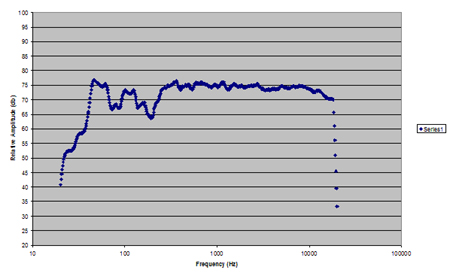
Figure 1: 1-meter on-axis analog sweep of taken at tweeter height, 1/3 octave smoothed, holding to around +/-1.5 dB to 10 kHz.
The response curve shows that the C2 is very linear above approximately 300 Hz. The problems begin below 250 Hz, where room effects begin to become obvious. As you can see, there is a big depression from about 110 Hz to nearly 250 Hz, with another dip from about 70 to 90 Hz. I have determined that these are due to room effects, as I see nearly the same response from my Apogee Caliper Signatures, a speaker of completely different design. In addition, nearfield measurements (not shown) revealed a very linear response from the woofer and the port when they were measured independently.
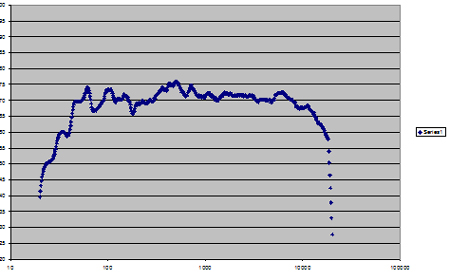
Figure 2: 1-meter 30 degrees off-axis analog sweep, 1/3 octave smoothed.
The off-axis response is a bit less smooth than the on-axis measurement in Figure 1. Of interest is the bump from around 550 to 650 Hz, which is the crossover region between the woofer and the midrange/tweeter. I confirmed this (see Figure 3) by using the biwiring posts on the back to measure each drive unit separately. The on-axis response looks well integrated, but the bump in the off-axis response could be due to a slight mismatch in the dispersion characteristics of the two drivers and the overlap in the driver response (not the usual 3 or 6 dB down at the crossover point). Also of note in Figure 2 is the rolloff of the high treble starting around 8 kHz, and the small bump in the response at around 6 kHz. Finally, note that the bass dips have filled in a bit, but the level through the lower midrange and bass is lower compared to that of the midrange and lower treble.
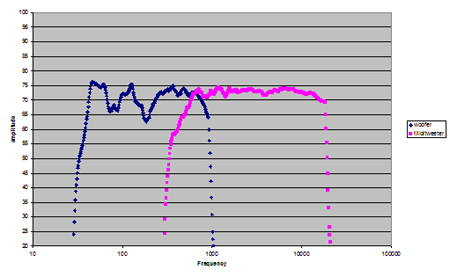
Figure 3: 1-meter on-axis frequency response of the individual drive units. Tweeter height, 1/3 octave smoothed analog sweep.
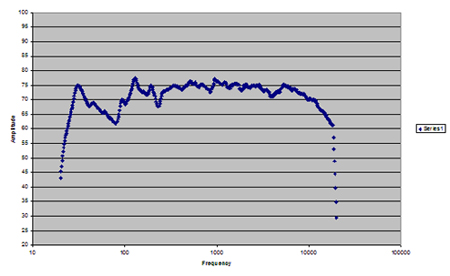
Figure 4: Both speakers, 3-meter in-room response at the listening position. Analog sweep 1/3 octave smoothed.
Figure 4 is the in-room response of both speakers at a level of around 82 dbA. The bump around the crossover seen at one meter appears to have significantly smoothed out at three meters. Again there is a distinct loss of energy through the upper bass, and the overall response of the speakers is midrange dominated. The small dip around 4 kHz and the spike around 6 kHz seen in the 1-meter sweep are still present. Notice that although the speakers were toed in somewhat, they were approximately 15 degrees off axis, yet we see nearly the same high-frequency rolloff that was observed at 30 degrees off axis. It is possible that this rolloff in the off-axis response led to a reduction in perceived ambience, but I am not sure about this. The lower mids do make sufficient recovery to give a relatively linear response from about 150 Hz to 8 kHz.
